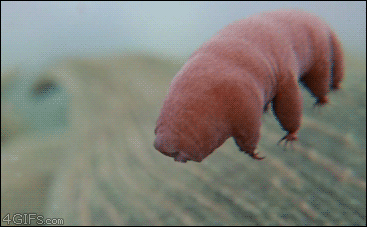The DU Lounge
Related: Culture Forums, Support ForumsInside the Bizarre Genome of the World’s Toughest Animal
http://www.theatlantic.com/science/archive/2015/11/tardigrades-worlds-toughest-animals-borrowed-a-sixth-of-their-dna-from-microbes/417243/ ?1448298061
?1448298061
They live everywhere, from the tallest mountains to the deepest oceans, and from hot springs to Antarctic ice. They can even tolerate New York. They cope with these inhospitable environments by transforming into a nigh-indestructible state. Their adorable shuffling gaits cease. Their eight legs curl inwards. Their rotund bodies shrivel up, expelling almost all of their water and becoming a dried barrel called a “tun.” Their metabolism dwindles to near-nothingness—they are practically dead. And in skirting the edge of death, they become incredibly hard to kill.
In the tun state, tardigrades don't need food or water. They can shrug off temperatures close to absolute zero and as high as 151 degrees Celsius. They can withstand the intense pressures of the deep ocean, doses of radiation that would kill other animals, and baths of toxic solvents. And they are, to date, the only animals that have been exposed to the naked vacuum of space and lived to tell the tale—or, at least, lay viable eggs. (Their only weakness, as a researcher once told me, is “vulnerability to mechanical damage;” in other words, you can squish ‘em.)
valerief
(53,235 posts)sort of like the GOP
![]()
JohnnyRingo
(18,624 posts)The article reveals that as it's only real world vulnerability. It's just cleverly stated.
valerief
(53,235 posts)If nothing else kills them (to our knowledge), then if they're not squished, they don't die is true.
Tace
(6,800 posts)From PopularMechanics.com:
http://www.popularmechanics.com/space/a11137/secrets-of-the-water-bear-the-only-animal-that-can-survive-in-space-17069978/
"The average lifespan of a (continuously hydrated) tardigrade is rarely longer than a few months."
valerief
(53,235 posts)a few months. I'm curious as to what kills them. Old age? What does that mean?
Thanks for the link.
cyberswede
(26,117 posts)I've never heard of these. The article that this one links to has a lot more info, too. Thanks!
BlancheSplanchnik
(20,219 posts)the perfect little critter! ![]()

Response to BlancheSplanchnik (Reply #3)
Marty McGraw This message was self-deleted by its author.
Kashkakat v.2.0
(1,752 posts)class of its own? Relieved to hear that it is microscopic. Had me worried there for a while.
tclambert
(11,085 posts)The classes have over 1,000 known species. they actually have their own phylum--Tardigrada. They've been around at least 530 million years, but weren't discovered until 1773. A full grown one could reach half a millimeter in length, big enough to see with the naked eye, yet went unnoticed until the age of microscopes.
So they are not insects, nor spiders, nor even arthropods.
Spitfire of ATJ
(32,723 posts)Hotler
(11,415 posts)LiberalElite
(14,691 posts)elias49
(4,259 posts)if they just hang out in a kind of suspended animation?
Strange stuff.
How do they reproduce? Maybe there have always been the same number of tadigrades in the world!
I wonder if they feed something else? Like big chunks of steel.
Ha! Tardigrades.
Then to find out there are something like 700 species of tardigrades I wonder where the hell I've been!
ashling
(25,771 posts)I still can't figure out what's the point of humans.
valerief
(53,235 posts)ashling
(25,771 posts)So what's your point?
![]()
![]()
valerief
(53,235 posts)Or remain pointless.
HeartoftheMidwest
(309 posts)..........SQUEEEEEEEEEEEEEEEEEEEEEEEEEEEEEEEEEEE.
![]()
47of74
(18,470 posts)tclambert
(11,085 posts)But it's likely they can't tolerate hard vacuum as well as Water Bears.
volstork
(5,399 posts)n/t
OnyxCollie
(9,958 posts)joanbarnes
(1,722 posts)FailureToCommunicate
(14,012 posts)Tough little fella been rocking the gym.
Marty McGraw
(1,024 posts)"vulnerability to mechanical damage"
So while they may survive the journey through the digestive tract, at least they will meet their demise in a final spectacular sphincter clench.
lonestarnot
(77,097 posts)Blue_Tires
(55,445 posts)and I can't tell if that opening at the top is a mouth or an asshole...
(Or maybe it serves both purposes ![]()
![]()
![]()
![]() )
)